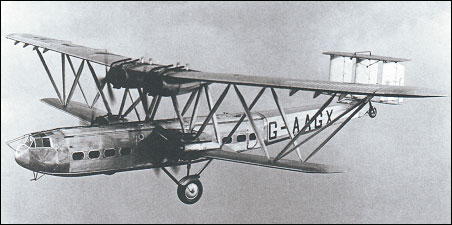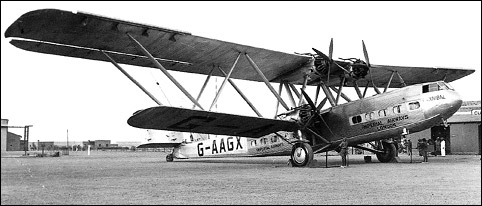|
| Commercial aviation got off to a slow start in the years immediately following World War I, and it was not until the mid-1920s that the pioneering civil airlines began to push out tentative long-range routes. In Britain the pace had been set by such companies as Aircraft Transport and Travel, British Marine Air Navigation Company, the Daimler Airways, Handley Page Transport and the Instone Air Line. Air Transport and Travel (Britain's first airline) ceased operations on 17 December 1920; the remaining four companies formed the building blocks from which Imperial Airways was created on 1 April 1924.
To Imperial Airways fell the task of establishing British commercial air transport on an economic basis, and with government backing it became possible - at least in a modest way - to begin the procurement of new aircraft and the survey and inauguration of air routes to link the British Empire. Needing more capacity than was provided by its 18-20-seat Armstrong Whitworth Argosy or 14-seat Handley Page W.10 aircraft, Imperial Airways acquired from the latter a total of eight aircraft designed specifically for use on the European and eastern sections of the Empire air routes.
Large biplanes, with a maximum wing loading of less than 48.2kg/m2, they were of all-metal construction except for the aerofoil surfaces and aft fuselage, which were fabric-covered. The unequal-span biplane wings were devoid of flying and landing wires, braced instead by massive Warren girder struts, and having ailerons and Handley Page slots only on the upper wing. The tail unit was also of biplane configuration, with triple fins and rudders, and the heavy landing gear was of fixed-tailwheel type. Power plant comprised four supercharged Bristol Jupiter engines, two mounted on the upper wing and one on each side of the fuselage on the lower wing. All
four engines were kept as near as possible to the aircraft's centreline, to minimise the problems of asymmetric flight in the event of an engine failure. For the first time in any British airliner the crew were accommodated inside the aircraft, in a compartment high in the fuselage nose which we would now call a flight deck. Within the main cabins - fore and aft of the wing area where the engine noise originated - passengers were provided with completely new standards of comfort and spaciousness. Those intended originally for eastern use (on the Indian and South African routes) carried six (later 12) passengers in the forward cabin and 12 in the rear, with space for 14.16m3 of baggage and mail amid-ships. The four equipped for the European routes (based at Croydon) carried 18 passengers forward, 20 aft and had 7.08m3 of baggage space.
The prototype flew first in November 1930. It was equipped subsequently for long-range service (H.P.42E, 'E' for Eastern) and named Hannibal. First of the H.P.42W ('W' for Western) for the European services was delivered in September 1931 and named Heracles. The remainder of this family of 1930s 'Jumbo' airliners had the names Hadrian, Hanno, Helena, Hengist, Horatius and Horsa. Remembered nostalgically in the early history of Imperial Airways, it was an unforgettable sight to see one climbing majestically away from Croydon or floating in on those enormous wings. Anthony Fokker once commented that H.P.42s had built-in headwinds, but their cruising speed of around 161km/h, excellent handling at low speeds and robust structure ensured that they were able to boast a decade of fatal-accident-free flight before being withdrawn from civil airline service on 1 September 1939.
| MODEL | H.P.42W (H.P.45) |
| ENGINE | 4 x Bristol Jupiter XFBM, 414kW |
| WEIGHTS |
| Take-off weight | 12700 kg | 27999 lb |
| Empty weight | 8047 kg | 17741 lb |
| DIMENSIONS |
| Wingspan | 39.62 m | 130 ft 0 in |
| PERFORMANCE |
| Max. speed | 204 km/h | 127 mph |
| Cruise speed | 153-169 km/h | 95 - 105 mph |
| Range | 805 km | 500 miles |
| Herman De Wulf, e-mail, 21.06.2010 13:16 I hear a group of enthusiasts is build or would like building an airworthy replica of the HP. Info anyone? reply | | Pete Bogué, e-mail, 07.08.2010 23:29 I was taken often to Croydon Airport as a small boy. You could watch the flying for a small fee from the terminal which still exists. My father somehow arranged for me to sit in the cockpit of the HP 42 Heracles. I was about 6 or 7 then in 1936 /7 - I am now 79 and a lot! That experience inspired me to fly - gliders at first and then, in the RAF, Jet fighters and helicopters and, later, business jets. But I still prefer Tiger Moths and piston engined 'tail draggers' generally. I was born a bit too late, but I would have loved to fly with the legendary Captain O.P. Jones - that was REAL aviation! reply | | bobby, e-mail, 10.08.2010 02:50 i mu aba of of muno reply | | Bernard Shaw, e-mail, 13.05.2010 16:48 I understand that a group of people, who also built a replice Vickers Vimy, are currently beavering away on a replica HP42. I am currently building a model of this lovely aircraft and have two sets of plans at two different scales that I obtained from MAP plans services. reply | |
| | les simmons, e-mail, 07.05.2010 20:47 dear david i would like a set of the rc plans if you can be so kind les reply | | Alan Coring, e-mail, 04.09.2010 14:22 Hi David
I remember as a lad buying the Aeromodeller magazine in 1955 which had an article on this model, and have decided, at a somewhat late stage in my life to attempt building this lovely aircraft. I have a copy of the original Newton plans as shown in the Aeromodeller but unfortunately much of the detail is difficult to read. If you can help in any way I would be much obliged. reply | | Jakub tetera, 06.01.2010 21:58 Is there any drawing of this aircaft? reply | | Jürg Gassmann, e-mail, 24.10.2009 15:54 Re Rodney Jones' query - i think Agatha Christie's "Death in the Clouds" is set on an HP 42. reply | | Tim Blake, 15.09.2009 19:12 Sam T. & Ken Wright. You ask if any of these aicraft (H.P. 42 /45's) still fly /exist. Sadly not. At the start of WW2 they were handed to the RAF for service but within 2 years all had been distroyed by either weather related incidents or airmanship issues. Such a shame, as in civilian use they put in nearly a decade of exceptional service even if somewhat basic by todays standards. You may however wish to note that the terminal building from which they operated at Croydon near London in the U.K has been preserved and is open to the public. reply | | David, e-mail, 04.09.2009 11:06 For those interested in RC plans I have them in PDF form.
Please reply to the email address and i will send them on.
cheers reply | | sam t., e-mail, 18.08.2009 17:59 Does anyone know if they are any HP 42's still around capable of flying? Appreciate any comments! thanks! reply | | Ken Wright, e-mail, 10.08.2009 01:46 Are there any HP42's in museums? reply | | Dennis Little, 26.07.2009 22:25 Still a beautiful thing to look at pictures of, even today. reply | | Alan Coring, e-mail, 19.01.2009 18:05 Does anyone know where I can obtain the plans /building instructions for making a model of HP 42 "Hannibal", designed by S Newton and featured in the December 1955 issue of The Aeromodeller? reply | |
| | Hugh C Stringer, e-mail, 21.11.2008 01:31 Can you give me any idea as to what the normal service ceiling, or flight level of these aircraft was? I am old enough to have seen them in flight !!! reply | | calum morris, e-mail, 09.02.2008 14:21 i dont think so, if they did its only one or two chapters, i think i have one but i cant remember its name, sorry!? reply | | Rodney Jones, e-mail, 02.02.2007 23:03 Have m /any novels been written about this aircraft? Thanks. reply |
|
Do you have any comments?
|
| 
COMPANY
PROFILE
All the World's Rotorcraft
|








